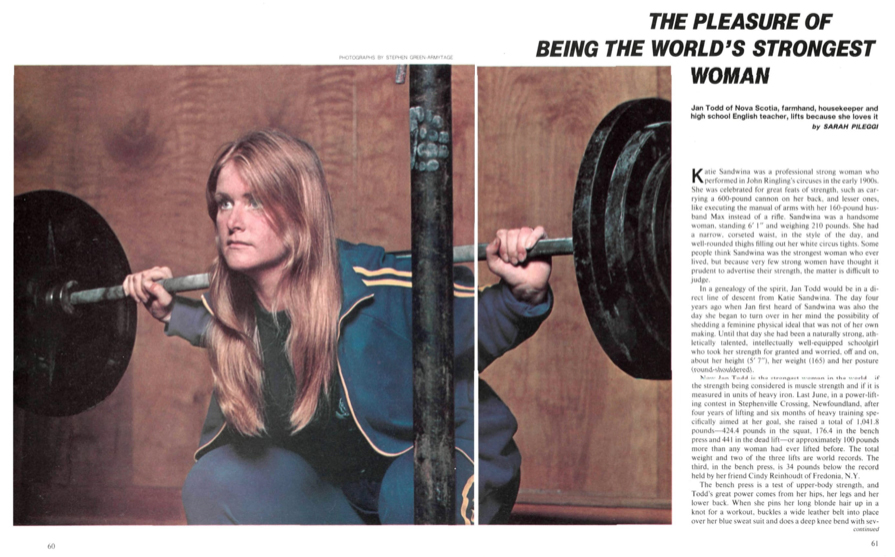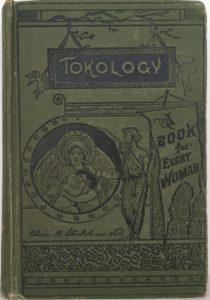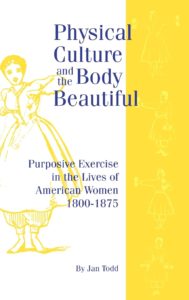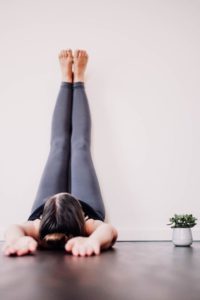the body beautiful // & how to pick a trainer

 Though before my time, the teenager standing in a used bookstore laughing over an antique 19th-century advice book in 1968 could have been me. Only 50 cents, Jan Todd, now a historian and professor of physical culture and sport studies at UT Austin, bought the 1885 classic, Tokology, A Book for Every Woman by physician-gynecologist Alice Stockham. In it she learned that rolling over (and over) in bed was proper exercise for young, aspiring mothers (i.e. all girls) during the 19th century.
Though before my time, the teenager standing in a used bookstore laughing over an antique 19th-century advice book in 1968 could have been me. Only 50 cents, Jan Todd, now a historian and professor of physical culture and sport studies at UT Austin, bought the 1885 classic, Tokology, A Book for Every Woman by physician-gynecologist Alice Stockham. In it she learned that rolling over (and over) in bed was proper exercise for young, aspiring mothers (i.e. all girls) during the 19th century.
This seems a far cry from…omg. Strongest woman in the world?!? The top image is from Sarah Pileggi’s November 14, 1977, Sports Illustrated article: “The Pleasure of Being the World’s Strongest Woman.” Though I’ve corresponded with Todd by email and hope to visit her, I didn’t know! Blame orals prep.
HOW COOL.
It is, let’s say, unusual to find practitioners in academia. One might even say it’s frowned upon, but we won’t.
Granddaughter of two turn-of-the-century “sideshow geeks” (see article), Todd discovered that women had worked as “professional strong women” in vaudeville and circus. The women, though large and muscular, were described as feminine and beautiful in newspaper reviews, which surprised Todd as it went against Barbara Welter’s accepted historical narrative, “The Cult of True Womanhood” as the ideal for women of the day. The ideal, of course, being white, straight, fragile, and of the upper class/es.
“Was it possible that some segments of Victorian society valued size and strength in women?”
Ah, the historical question. A clear historical question, and one to which I relate. This is rare and it excites me.
Todd, a once-professional powerlifter and teacher, wondered about both her ancestors and the origins of her sport. It sent her deeper into the past and she began research on women’s exercise. While women’s sport history began in 1973, few historians have studied women’s “purposive exercise,” an “always rational endeavor undertaken to meet specific physiological and philosophical goals…about creating a new vision of the body. Nineteenth-century women picked up dumbbells, took long walks, and joined together in calisthenics and gymnastics classes for basically the same reasons women exercise today: the implicit promise of improved appearance, the quest for better health, and a desire to feel stronger and more competent” (Todd, 3).

Todd’s book, Physical Culture and the Body Beautiful (1998), was one of many health books on my orals list, and her topic and method resonated with me. Her questions were driven by her own experience, which seemed to follow a “how did we get here” line of questioning I know well. She asked questions, hunted down answers, and methodically described them in a detailed chronological narrative that would interest only the…interested, ie those interested in the history of exercise.
Perhaps I should break the book-post series here to share an update on why I’ve just been posting probably-boring-to-most and seemingly-unrelated book summaries and reviews this year. The timing is good, as this site has an anniversary of sorts in a few days.
Though I haven’t been posting regularly in years (and now once a month), I started the site as a project for a health-promotion media class in 2007, when working on a masters degree. That html site morphed into a blog (coccoyoga) in 2009. The Cleveland Clinic was not posting how-tos on yoga back then, to be certain. Wow, how times have changed.
I updated regularly for years (some since deleted), though over time the name of the site changed along with me. I slowed because I lost motivation. My writing was not very, very clear.
Often I’m told that I need to spell things out more. To connect the dots with a big, thick, gaudy marker and then show some diagrams. That is not my style and it bores me. Though, sure, so many missing my point also irritates me 🙂 . So I stopped posting regularly seven years ago, around 2015, and just updated when students needed something.
The increasingly politicized interwebs sent me deeper into questions about how we came to do what we do in health and “wellness,” and I realized the only way I could find the time and motivation to research it was in a funded PhD program. This isn’t easy, as academia is centered around investigating certain well-traversed questions, and my questions have not been trendy since the 1970s—a defining decade indeed (see SI article above). But I was spectacularly lucky to find a program within walking distance of my home, where a group of brilliant, kind, wise, and patient scholars have put up with me for the last few years.
 As I studied for the qualifying exams, or oral comps as they’re usually called in history, I wrote out summaries or reviews for books that I wanted to get at and I posted some of them here, to give students an idea of where my offhand comments came from in class (yes, sources). And now as I delve into my research, I’m still doing this for the books that are central to my project, which is situated between two topics jumbling around for cohesion in my mind. Maybe they can even be connected. More on that later.
As I studied for the qualifying exams, or oral comps as they’re usually called in history, I wrote out summaries or reviews for books that I wanted to get at and I posted some of them here, to give students an idea of where my offhand comments came from in class (yes, sources). And now as I delve into my research, I’m still doing this for the books that are central to my project, which is situated between two topics jumbling around for cohesion in my mind. Maybe they can even be connected. More on that later.
Todd’s book impressed me because it’s straightforward and clear in both prose and methodology. When I looked her up, I discovered that she and her husband started a massive physical culture (/exercise) archive at UT Austin, but I missed the old SI article about her.
When Professor Todd was a college student in Macon, Georgia in the early 1970s: “She worked the whole time she was at school…she had a sort of love-hate relationship with the college president. She was a thorn in his side when she was editing the paper, but once I heard him say. ‘She’s a helluva man.’ That was his greatest compliment.”
This is somewhere I could elaborate more, but I choose not to. Some will get it regardless.
In her senior year, guided by her partner, Todd began using dumbbells to correct her rounded shoulders.
!
Seriously?
In the last few weeks I’ve been asking personal trainers about strengthening my back because I lose my battle against a tendency toward excessive kyphosis (which includes rounded shoulders) when I sit for too long, which, working on a PhD, is all the time. Of course decades of yoga have helped me tremendously and my usual posture is no longer a slump. Incidentally, gaining flexibility in my upper thoracic spine did not come from intense ashtanga, even the exhilarating dropbacks, but from lying in the sauna with my arms stretched back on the bench behind me, upper arms alongside my ears, for as long as reasonably comfortable. In fact, doing this in legs up the wall after a long day of sitting feels amazing and can elicit a small yelp of pleasure-pain.

Youtube videos by trainers on this issue are not that useful, frankly. One of the top search returns features a guy who looks like he just pushed his shoulders back to stand up straighter without correcting the underlying cause.
Am I saying yoga and youtube aren’t helpful here? No and yes. We develop habits, and my body knows how to cheat where she needs to in even the most dramatic yoga poses. This isn’t good and over time will cause injury.
To break habit I want to come at this from a totally different modality. Around T8 to T10 I am still totally locked on most days. I cannot even feel this area so it’s difficult for me to know what I’m doing without good feedback.
What? A yogi can’t interocept?* No. Though I’m morbidly aware (some might say)** in most parts of my body, this area is virtually imperceptible to me. Learning new patterns is possible on one’s own, but help goes a long way.
Coincidentally, last fall I joined a gym because my usual sauna was still closed due to covid. As part of the welcome package I got a few training sessions but didn’t have time to use them while prepping for orals. Yeah. I just went there for the clean and gorgeous sauna. And towel service.***
Last month, I finally got around to booking a few sessions. Finding a good trainer is much like finding a good yoga teacher. You might need to try many to find someone who resonates with you. The concierge won’t love you, but always ask to try a few different people unless you adore the first. Trainers have different takes, and you need to feel they offer you guidance that resonates in your body/mind. You aren’t going to agree on everything, but the sessions need to click. You need to be pleased.
Apologies here, but it’s a je ne sais quoi that a listicle isn’t going to cover. I imagine there are many “signs a trainer is right for you” quizzes out there and if you’re new, sure, they could be helpful.
Yes, the sessions should click even if you aren’t body aware or into exercise at all. Don’t assume that just because someone’s been training or teaching yoga for decades that they are a good fit. If you can’t afford a few private sessions, find a weight training class at a Y and ask the various instructors a million questions. Some might prefer this to one-on-one anyway.
Why gym training and not, say, pilates? First, pilates is very similar to yoga. Second, I find it boring. Third, my foray into intentional fitness started by working out in a gym, and from 1989-1995 I lifted weights and did gym stuff, eventually taking weight training classes at uni and working in the school gym. I stopped when I started traveling and yoga was more accessible. Now I want to see how it can inform my yoga.
How did I end up here? Oh yes, Todd started lifting to correct her posture and became curious about powerlifting and its history. I’ll start here next time, as this is long and it’s quite hot.
*I made interoception into a verb while teaching. Sorry grammarians, the kids are winning.
**While you can stagnate or indulge mental (some might say secondary or imagined) emotions, you cannot dwell for long on the sensations of emotion in the body. Sensations are always shifting, changing, and informing. They move. Dwelling requires stagnancy.
***I could write a diatribe on finding a decent gym sauna. I even tried one of those ridiculous tent things. There are over thirty gyms within a mile of me and only two were acceptable. Many gyms don’t bother to maintain their saunas (several were at ~80ºF when I visited [NYSCs], even though they knew I was coming to try the sauna.
My gym is big on triathlete training and they are into hot/cold extremes, so it’s usually in good shape and people observe comparatively good etiquette, which could easily be yet another post. (Please do not wear shoes from the street or work out in a shared sauna. Please. Saunas are spiritual places (yeah, really) of relaxation and renewal for many northeastern Europeans. Neked on or in a towel, good. Sneakers, barbells, and pilates, bad.)
One day I will have a sauna and cold plunge at home, but even so, sauna is at heart a community endeavor.
I just discovered your site by accident as I was looking for an e-book version of my book–which someone told me they had seen on line. I am staggered by your effusive kindness toward my book, and just wanted to say that I hope you passed comps! I also wanted to correct one small matter in this post. My husband, Terry Todd, loved to tease, and when Sarah Pileggi spent time with us for the article in Sport illustrated, he told her in jest that two of my grandparents were circus geeks which was not in any sense true. My grandparents were all from western Pennsylvania and consisted of two housewives, a carpenter, and man who worked in a steel mill. Sports Illustrated later printed a correction. Thanks again for taking such time. I’m glad you liked the book. Jan
Thanks so much for the comment. Yes, I passed comps and am writing my dissertation now. The circus geeks tease ending up in print is hilarious, as I’ve been known to tease in this way myself. And I also have grandparents from Western PA steel country. Such a small world! Hopefully I’ll make it to UT soon.
Anastasia